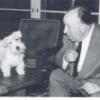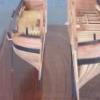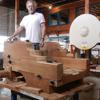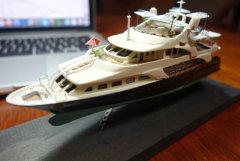-
Posts
366 -
Joined
-
Last visited
Reputation Activity
-
 steamschooner got a reaction from Martin W in HMS Pegasus 1776 by Mirabell61 - FINISHED - scale 1:64 - 16-gun sloop
steamschooner got a reaction from Martin W in HMS Pegasus 1776 by Mirabell61 - FINISHED - scale 1:64 - 16-gun sloop
Nils, Are you using safety glass for you case? Do you prefer glass over say plastic? Do you build in some sort of venting for the case to breathe.
Someday I will need to build some cases to keep the eightlegged riggers from adding additional lines.
-
 steamschooner got a reaction from avsjerome2003 in HMS Pegasus 1776 by Mirabell61 - FINISHED - scale 1:64 - 16-gun sloop
steamschooner got a reaction from avsjerome2003 in HMS Pegasus 1776 by Mirabell61 - FINISHED - scale 1:64 - 16-gun sloop
Nils, Are you using safety glass for you case? Do you prefer glass over say plastic? Do you build in some sort of venting for the case to breathe.
Someday I will need to build some cases to keep the eightlegged riggers from adding additional lines.
-
 steamschooner reacted to captainbob in USCG Pequot (WARC-58) by captainbob - FINISHED - 1:96
steamschooner reacted to captainbob in USCG Pequot (WARC-58) by captainbob - FINISHED - 1:96
Finally the holidays are over and I can get back to modeling. In painting the hull I messed up the rivet band so that had to be redone. Plans are to paint the bulwarks and deck, install the rail and start on the cabins. Here are the pictures for now.
Bob
-
 steamschooner reacted to Mirabell61 in HMS Pegasus 1776 by Mirabell61 - FINISHED - scale 1:64 - 16-gun sloop
steamschooner reacted to Mirabell61 in HMS Pegasus 1776 by Mirabell61 - FINISHED - scale 1:64 - 16-gun sloop
Name for standplate and start of display case
the standplate gets two identical nameplates, depending which side will be turned to front later on. The glass display case will be L x W x H , 90 x 26 x 75 cm,
The wooden base and the framework will be stained in cherry tone, before the parts are mounted. The ordered glass panes and the reinforcement metal corners I am holding already
Nils
-
 steamschooner got a reaction from mischief in Whaling Ships found in Alaska
steamschooner got a reaction from mischief in Whaling Ships found in Alaska
http://sanctuaries.noaa.gov/news/press/2016/lost-whaling-fleet-found.html
No pictures but interesting.
-
 steamschooner reacted to EdT in Young America 1853 by EdT - FINISHED - extreme clipper
steamschooner reacted to EdT in Young America 1853 by EdT - FINISHED - extreme clipper
Young America - extreme clipper 1853
Part 132 – Forward Lockers
There were two forward lockers that abutted the forecastle breast beam and the bulwarks at the side. The enclosure on the port side was evidently (also?) used as a toilet. These were undoubtedly used to stow gear that needed more protection than that afforded under the open forecastle.
With the windlass permanently installed, these enclosures could be constructed and the ladder ways between them and the windlass also installed. In the first picture a panel of siding has been edge glued and is being fitted between the rails of the port bulwark.
After fitting, the panel would be cut off square to size. These would most likely have been made using tongued-and-grooved planks maybe 2½” thick. To accentuate the plank joints, the edges were rounded before edge gluing – as was done for all the other deck structures.
The next picture shows some pieces in assembly.
Although the workshop is in the basement, I get very bright sunlight through the windows this time of year – hence some overexposure in some of the pics. In the next picture the end walls have been fitted and the fore-and-aft wall with the door is being test fit.
In the next picture the wall has been installed, the roof has been planked and is being smoothed out.
The flat faced curved riffler is being used for this. Note that door hardware was installed prior to setting the wall. In the next picture the edges of the roof planks are being pared flush with the chisel.
The next picture shows both enclosures installed.
The ladder way on the starboard side is also installed and the glue on some decking for the port ladder is drying. In the last picture the second ladder way has been installed and roof planking on both enclosures painted.
Ed
-
 steamschooner reacted to EdT in Young America 1853 by EdT - FINISHED - extreme clipper
steamschooner reacted to EdT in Young America 1853 by EdT - FINISHED - extreme clipper
Young America - extreme clipper 1853
Part 131 – Belaying Pins
Actual modeling work on Young America has been slow through the holiday period, but I have been putting a lot of effort into research on her rigging and the development of a detailed rigging list with specs for all the lines. This has been a slow process because rigging was undergoing constant change through the life of the ship – for example moving to the use of iron for many attachments and rigging lines (chain, wire) as well. Also, sources on sizes, where they exist, vary. This work will go on for some time.
As this “paperwork” has progressed, it has thrown off a variety of diverting questions as to how many (small) parts will be made – for example shackles, iron strapped blocks, gin blocks, etc. I decided to tackle iron belaying pins as a side project, but one that arises soon in the construction.
Model belaying pins often suffer from poor proportionality – generally being too large – especially the wooden variety. I am determined that the 250 or so of these on the YA model will not suffer from this, so I began work on making these.
This started with the use of brass tubing to create a steady rest around a brass rod so these could be turned in the lathe. This did not work well on the .032” brass rod needed for these. The next step was to try filing these in the lathe using the simple hardwood guide shown in the first picture.
The block was stepped and shaped to the pin outline. A v-shaped groove was cut on the lathe centerline to contain the brass rod. The next picture shows some filing in progress.
The results were not too bad – as far as being proportional at least. The first few made this way are shown below.
While these are about the right size there is variation in their shapes that needed to be eliminated. A few of these have been blackened to simulate the iron of the originals.
I decided that a much more accurate filing guide was needed and decided to make it to fit in a lathe tailstock chuck – and also to make it robust so it would not bend or break as 250 of these pins were made. In the first picture a ¼” brass rod is being indicated in the 4-jaw lathe chuck so a deep .032”center hole could be very accurately drilled.
A small center drill in the tailstock chuck was then used to spot the center. The .032" hole was then drilled to about .6 inches. The rod was the transferred to the milling machine for cutting the belaying pin profile.
To cut the profile, a very accurate CAD drawing of the pin profile was made showing the precise cutting depths and positions so these could be set using the mill's calibration wheels. In the next picture the guide has been set up in a tailstock chuck and the brass rod passed through the headstock drill chuck and into the guide.
With the rod contained in the guide the profile could be filed with the lathe running. In the next picture a round file is being used to shape the concave handle curves.
The diameter of the lower part of the pin is about 1½” (.021” actual). This is being filed down with a flat file in the next picture.
As each of the first few pins were made the guide itself was filed to refine the convex curves of the pin handle that were not easily cut on the mill. Some of the first few pins are shown in the next picture.
These look better and should be satisfactory. They will be mostly hidden by rope coils. Some more polish may help with the blackening and these should get better with practice. These took less than 5 minutes each. This will get tedious so I am interspersing it with other work need to complete the deck detailing.
Ed
-
 steamschooner reacted to shipmodel in SS Andrea Doria 1952 by shipmodel - FINISHED - 1/16" scale
steamschooner reacted to shipmodel in SS Andrea Doria 1952 by shipmodel - FINISHED - 1/16" scale
Build Log 15 – Final Details
Hi and Happy New Year to all, and thanks as ever for the likes and comments.
This will be the last installment of this build log, covering the final details that add another level of interest to the model. Many of these are elements that can be changed at the discretion of the captain, so I used as my guide the photographs taken at the time of the sinking.
The first detail was the wires for the short wave radio antenna. These do not show up very well in photographs since they are so thin. On the plans they are shown, but not separated from the mast support wires. Close examination of various photographs show that not all of these wires were installed on the actual ship. Presumably the antenna wires changed as the radio was upgraded during the life of the ship.
There is a cylindrical structure on the starboard side of the Sun Deck just aft of the Command Deck area. Several wires lead to it so, although it is never identified, it is clearly part of the radio system.
Without any clear guide, I decided to include three wires for the antenna. Two lead from near the top of the mast to thin poles at the aft ends, port and starboard, on the Lido Deck. The antenna wires are separated from the poles by short lines with three insulators. These were made by mixing white paint with white glue, then attaching small drops to the line with a toothpick. Several coats were needed since the glue shrinks as it dries and had to be filled out again.
The third line runs from a bit lower on the mast to the top of the funnel. All three lines are then connected to the radio fitting with vertical lines. All of the radio wires were made from fine embroidery linen in an off-white tone. I tried several other materials and colors, but this gave the best look, in my opinion. It is light enough to show up in most light, but thin enough not to be overpowering.
In photographs of the ship taken on different days, there appear or disappear various sets of canvas railing cloths to protect the passengers from sea spray. These were hung on the outside of the railings and laced to them. On the day of the sinking there were railing cloths up to the level of the boat deck and around the command deck.
I modeled the cloths with stiffened batik fabric cut to fit and glued against the appropriate railings. Unfortunately, once everything was dry the fabric proved too transparent, and had to be given a coat of opaque white acrylic. But the glue proved too strong and I risked damage to the rails, so the first ones had to be hand painted on the model, while I could paint later ones before installation. Live and learn, eh?
I was surprised at how much of a visual difference the cloths made to the overall appearance of the model, especially when viewed from amidships. Here are before and after photos.
The passengers were also protected from the weather and sun by canvas awnings supported by metal frames, although no photo shows the awnings spread. Perhaps that was only done in port. The simple frames on the Lido deck are mostly hidden behind the lifeboats, so I did not model them, but the aft taffrail deck was set up with a large awning over a complicated and interesting metal frame. It would be a nice element to include.
The frame was made up of four flat arches of differing widths set across the deck and tilting down from forward to aft. They were connected to each other with a straight bar running along the centerline.
For the model the frames were bent up from 0.030” brass rod. Getting them to fit predrilled holes in the deck and still have the correct arch took a lot of trials and even more errors. Once they were shaped the problems first started. I planned to solder them together in a jig, then electroplate them in chrome. I was spectacularly unsuccessful. Once soldered in the jig, the assembly bent and/or came apart as it was removed. Several times. Metalworking skills are not my strong suit. I never even attempted electroplating. The final solution was to mount the arches on the model with the connecting bar attached with small dots of epoxy. Once everything was set in place the deck was protected with a piece of paper toweling and the brass was hand painted with primer then silver acrylic paint. Happily, it turned out to be quite strong and convincingly metallic.
Some small details were added around the ship. A dozen green storage bins were scattered around, a searchlight was installed on the aft end of the Promenade Deck near the third class pool, and photoetched life preserver rings were mounted outside of the railing cloths on the boat deck. Ensign staffs were mounted at the extreme bow and stern. All of these give the model a bit more 'texture' and realism.
It was finally time, a year after laying the keel, to hang the flag on the ship and get her ready for launch. It was made in my usual way by printing out a skewed image of the flag. At this scale the material was silkspan, which is transparent enough that I did not have to print the reverse side. It was hung on a halyard running from the tip of a gaff to a cleat on the base of the mast, then misted with water and gently curled.
There was one final detail to attend to. You may have noticed in earlier photographs of the first and second class pools that a clock was mounted on the overhang at the forward end of each area.
I made them up from 1/10” o.d. brass tubing filled with a wooden dowel. After flush sanding the wood the brass bezel was chamfered on a sanding belt. The wooden face was painted white. Tiny black dots for the numbers were touched on with the tip of a sharpened toothpick. With my finest 10/0 brush the hands were put on. The extreme close-up photos show that I was less than perfect, but with the entire clock being less than 1/8" in diameter, I have reached the limits of my talents.
The clocks are set to 11:05 p.m. In five minutes the lives of Linda Morgan’s parents, sister, and dozens of others will end and she will be thrust into unwanted publicity. In just five minutes.
But for now, in miniature, she sails off the workbench to the customer.
I hope you liked the journey despite my sometimes clunky sense of humor. I will post a photo tour of the finished model when I can. Until then . . .
Be well
Dan
-
 steamschooner reacted to Cathead in Bertrand by Cathead - FINISHED - 1:87 - wooden Missouri River sternwheeler
steamschooner reacted to Cathead in Bertrand by Cathead - FINISHED - 1:87 - wooden Missouri River sternwheeler
Lots of progress lately. By the end of this post, Bertrand will be ready for the final bits of rigging and details. The end is in sight! Here we go:
Pilot house
Here I'm laying out pieces for the pilot house. Like the cabins, this uses pre-scribed wood, though I'm cutting & staining the window & door frames individually. I didn't have anything that small on hand, so split each piece manually from wider strips, using a hobby knife.
Here you see the pilot house partially assembled. You'll notice that I made the windows with two layers of wood, technically not accurate since a real window would have the panes and frames all in one plane. I decided that I didn't have the skill to make perfect square small-paned windows like these in 1:87, so went with the two-layer approach as a reasonable approximation. One reason I stained the windows dark, is to help hide their 2-D nature. The resulting shadow keeps the eye from seeing that, compared to if they were all white. And I think it looks nice. When you step back more than 6", it's hard to see the difference.
Here's the pilot house installed, with a beginning to the clerestory roof. I carved a series of roof braces with a gentle curve to support this area, instead of bothering with full rafters, as this can't be seen from any angle. Much easier. Then I just planked in both roof areas as I'd done the hurricane deck, using the same pre-coloring technique with pastels. If you look real close, you can see the wheel, which I made by cutting a hoop from the styrene tube soon to be used for the chimneys, and gluing thin styrene rods radially. I thought I took pictures of this process, but can't find them now. Oops.
Chimneys
Though the model railroader in me wants to call these smokestacks, apparently the steamboat world generally called them chimneys. In any case, these were built from two diameters of styrene tubing, one of which slides neatly into the other. I cut a series of hoops from the thicker diameter, and drilled holes in styrene sheet to create a kind of cover plate for where the chimneys cross the hurricane deck.
Middle photo shows the assembled chimneys. The thicker, lower section simulates the heat shields such chimneys used to protect passengers on the boiler deck from the hot chimney pipes. The various hoops simulate thicker iron bands on the chimneys, placed approximately where various plans and period illustrations suggest they should be. As styrene is too smooth and shiny to really simulate rough iron to my eye, I used a past trick of mine and wrapped the chimneys in layers of strong masking tape, making each seem a quarter turn from the layer below. These seams simulate the chimneys' construction from tubes of iron, and produce a nice rough texture.
On the right, you see the painted and installed chimneys, weathered with rust-colored pastels. I think they look convincingly like frontier iron work.
Stairs
Three sets of stairs are needed to reach the pilot house from the boiler deck; one from boiler deck to hurricane deck (right), one from hurricane deck to clerestory roof (not shown), and one from clerestory to pilot house (left). I built these in the same manner as the main staircase from main deck to boiler deck, described before in this build. In the background, you see some hog chains, which I'll discuss soon.
Boiler deck railing
Probably the most fiddly part of this build. I'm not entirely happy with how these came out, but they look fine from more than a foot away. I started by building the internal railing that keep passengers from falling down the main stairwell (left). Then I glued a long, painted strip wrapped around all the stanchions on the boiler deck, as the upper rail (center). Then I hand-cut a whole whoppin' mess of little railing posts to line the railing with, and carefully levered each one into place with tweezers and a dab of glue. Once again, step back a foot and it looks great. Up close, it looks like the work of someone still developing his fine-woodworking skills.
(Almost) completed steamboat
And here she is, very close to done. This is the best view of the hog chain system, the longitudinal iron trusses that keep the bow and stern from sagging in a ong, thin boat with no keel and lots of stern-weight. These I simulated with fine rigging thread painted black, run through holes drilled in the decks and stretched tight. They should have turnbuckles on them for tensioning, which I haven't decided how to simulate yet.
All that remains is the "rigging", which in this case means a few support cables for the chimneys, and the various cables and tackles for the grasshopper spars, which I'll discuss when they're done. There are a few other details, such as hoists and tackles for two launches, and splitting some 1:87 firewood for the main deck. But she's close.
One question for you all: how would you go about lettering the name, which should go in large black letters on the engine-room wall just forward of the wheel? I've never done lettering before.
Hopefully within two weeks I'll post the absolutely completed Bertrand. In the meantime, just two days late, here's Dave Hum playing the Eighth of January, an old tune named for the British defeat at New Orleans that closed the War of 1812, just over 201 years ago:
-
 steamschooner got a reaction from druxey in Whaling Ships found in Alaska
steamschooner got a reaction from druxey in Whaling Ships found in Alaska
http://sanctuaries.noaa.gov/news/press/2016/lost-whaling-fleet-found.html
No pictures but interesting.
-
 steamschooner reacted to ggrieco in Heroine 1838 by ggrieco - FINISHED - Scale 1:24 - Western River Steamboat as she appeared before hitting a snag in the Red River
steamschooner reacted to ggrieco in Heroine 1838 by ggrieco - FINISHED - Scale 1:24 - Western River Steamboat as she appeared before hitting a snag in the Red River
Hello,
I hope everyone had a great New Years! I spent the last week playing catch-up after taking some time off with the family.
The rest of the machinery requires some of the deck to be in place so that took up most of my time this last week. Heroine's planking isn't pretty! The widths of her planking range from 3" up to 15" and there is very little pattern to it. In the stern, the port side planking ranges from 6 to 10 inches and the corresponding area to starboard is made up of 3 to 6 inch planking. Although some of it is repairs, some of it looks like they ran out of the wide planks quickly and made due with whatever they had.
Guard planking completed. Kevin discovered the remains of black paint on the hull timbers and the guard cap. He believes the Upper works were white with black trim.
Starting to add deck planking. One of Heroine's cam frames in back for scale.
This cam frame was in the bow compartment as a spare. It was late coming out of conservation and I haven't had time to model it in AutoCAD for machining. That will be my first task for next week.
Close up of repair to cam frame.
Close up of wedge in one arm of the cam frame. It appears that when the splint was riveted to the frame there was still some play so they drove this wedge in.
-
 steamschooner got a reaction from Ray1981 in Whaling Ships found in Alaska
steamschooner got a reaction from Ray1981 in Whaling Ships found in Alaska
http://sanctuaries.noaa.gov/news/press/2016/lost-whaling-fleet-found.html
No pictures but interesting.
-

-
 steamschooner got a reaction from dgbot in Whaling Ships found in Alaska
steamschooner got a reaction from dgbot in Whaling Ships found in Alaska
http://sanctuaries.noaa.gov/news/press/2016/lost-whaling-fleet-found.html
No pictures but interesting.
-
 steamschooner got a reaction from GaryKap in Whaling Ships found in Alaska
steamschooner got a reaction from GaryKap in Whaling Ships found in Alaska
http://sanctuaries.noaa.gov/news/press/2016/lost-whaling-fleet-found.html
No pictures but interesting.
-
 steamschooner got a reaction from Canute in Whaling Ships found in Alaska
steamschooner got a reaction from Canute in Whaling Ships found in Alaska
http://sanctuaries.noaa.gov/news/press/2016/lost-whaling-fleet-found.html
No pictures but interesting.
-
 steamschooner reacted to Piet in Surabaya by Piet - 1/80 - Mid 17th-Century VOC ship
steamschooner reacted to Piet in Surabaya by Piet - 1/80 - Mid 17th-Century VOC ship
Hello all and thanks for visiting the Surabaya shipyard. Thanks for all the likes and your comments.
Thank you Jan. Yeah, I guess that makes sense, that they would come in different sizes for different applications. I should have made them a hair thicker and perhaps a little closer together at the top but it's mostly the idea that counts in how they look like.
Yeah Ian, I forgot already that Jan mentioned it in a previous post that the kruishouten were called kervels, old age disease It also makes sense that these hoornklampen are called pin racks.
All I did with the making the pin racks was to draw them out on a piece of flat boxwood sheet of about 1.5 or 2 mm thickness. Then drilled the appropriate size holes for the pins and proceeded to cut them out. I made the pins from bamboo skewers. First splitting them into thinner pieces and then pulling them through a drill size plate.
I drilled a 1/2 mm hole in the foot of them and cemented a small piece of 1/2 mm brass rod in. Drilled a 1/2 mm hole in the mast and cemented them in using 2 part epoxy glue.
In my case I could not drill the holes in the main mast because it was already installed and not accessible. Oh, I could have bend a steel needle to 90 degrees and carefully pushed that in making a hole but was concerned about collateral damage in other places. I just cemented them on with CA.
It's obviously better to do this kind of work when you have the masts on the bench.
I'm coming close to having to make a few carvings and the lower mast tops to start with the standing rigging.
I may have to investigate this casting business like Sawdust Dave is doing, it'll speed up that chore
I think I have pretty much put all the fixed rigging parts on the ship except for a few lead-through holes in the bulwarks and eye bolts. I'm hoping that I can do that when it's needed using the appropriate drawings Jan and Hans have send me.
By the way Jan, I have ordered Rob Napier's book "Valkenisse." Hip, hip, hurrah !!! That'll help with the rigging together with the Heemskerk and Batavia. Besides, I just love these Dutch ships, there is something about them - - -
I'm currently working on the stern knees and flagpole. That'll kinda complete the hull work besides mounting a few cannons and then cleaning all the dust out of her.
Here are a few pics of the last two day's work.
This shows version 2.0 of the kruishouten aka kervels, the three remaing hoornklampen aka pin racks, four boordknights and two three pulley deck nights.
Here we see the version 2.0 kruishout, aka kevel, bolted to the frames, a longer pin rack and one boordkecht that you can see just left of the mast bolted to one of the frames. Now a not so funny thing is that I forgot to drill the holes for the simulated pulley inside of it I'll either have to worry the holes in using a pin vice or ripping them of and doing it the easy way.
This shows two of the version 2.0 kruishouten, kaka kevels, bolted to the bulwark in the wast.
This shows a longer pin rack and a boordknecht on the quarter deck. Same sad story about the boordeknecht.
Cheers,
-
 steamschooner reacted to Piet in Surabaya by Piet - 1/80 - Mid 17th-Century VOC ship
steamschooner reacted to Piet in Surabaya by Piet - 1/80 - Mid 17th-Century VOC ship
This is the post I planned to issue yesterday, or was it day before yesterday, but had to postpone it till now.
In the meantime The "kruishouten" and "hoorn klampen" were finished and cemented to their various locations. A literal translation is "cross woods" and "horn clamps".
There is of course a change coming with the kruishouten but that 'll be for another day.
This shows the kruishouten cemented to the bulwark, port side, waist. Hmmm, kinda small - - -
This shows the kruishouten as well as one of the hoorn klamped to the mainmast.
Here we see one of the two hoorn klampen with their karvijnagels cemented to the foremast. The karvijnagels acts as belaying pins but are permanently attached to the klampen.
Looking at the pictures with the kruishouten cemented to the bulwarks they seem too small. I decided to make them a little larger and see how they look. I kinda like the size - - unless Jan thinks they are no good and need a different shape and be a little heavier. I copied the idea from the Prins Willem book. No problem with that, I can easily rip them out and redo them. I'm so used to redoing that it's becoming routine
Cheers,
-
 steamschooner reacted to Remcohe in HMS Kingfisher 1770 by Remcohe - 1/48 - English 14-Gun Sloop - POF
steamschooner reacted to Remcohe in HMS Kingfisher 1770 by Remcohe - 1/48 - English 14-Gun Sloop - POF
Finally after a one year, the basic structure of the upper deck is finished. I never realised I was that slow building my ship :-)
I don't plan to add more ledges between the carlings so there is a better view at the lower decks. Cutting the mortice in the wing transom was a bit tricky, especially as they had to be right the first time.
Time to add tome more bits to the deck.
Remco
-
 steamschooner reacted to Omega1234 in Majellan by Omega1234 - FINISHED - 1/200 - Luxury 37 m Motor Yacht - Miniature
steamschooner reacted to Omega1234 in Majellan by Omega1234 - FINISHED - 1/200 - Luxury 37 m Motor Yacht - Miniature
Hi everyone and many thanks for all of your comments and well wishes for the New Year! Greatly appreciated.
I've done some more work on the major components of the superstructure; paying particular attention to how they can be removed easily for viewing.
Here are the latest progress shots.
Cheers
Patrick
-
 steamschooner got a reaction from ggrieco in John Cudahy by steamschooner - FINISHED - 1/4" scale - Steam Tug
steamschooner got a reaction from ggrieco in John Cudahy by steamschooner - FINISHED - 1/4" scale - Steam Tug
I posted this in another area as well. I am working on some of the deck gear/fittings and this is one of the puzzles that has come up.
photo shows the forward side of one side of the H bit with what looks like a pawl mounted on the right. Than just below and to the right is a warping head ( looks like it has whelps ) The other stuff is part of the steam gear that was also on the fordeck. That's another project in itself. This is what I think I might be looking at.
Any thoughts , ideas ,
-
 steamschooner got a reaction from mtaylor in John Cudahy by steamschooner - FINISHED - 1/4" scale - Steam Tug
steamschooner got a reaction from mtaylor in John Cudahy by steamschooner - FINISHED - 1/4" scale - Steam Tug
jbshan: Yes now days three lights are required. The time frame of 1900-1930 there were only two mast lights ( see photo at the begining of my log ). The laws did not change until later, the Cudahy(now the Henry Foss ) likely had three when she was lost in 1952
-
 steamschooner got a reaction from Omega1234 in John Cudahy by steamschooner - FINISHED - 1/4" scale - Steam Tug
steamschooner got a reaction from Omega1234 in John Cudahy by steamschooner - FINISHED - 1/4" scale - Steam Tug
Yes, thank you Mark, and a great New Year to you and yours.
-
 steamschooner got a reaction from dgbot in John Cudahy by steamschooner - FINISHED - 1/4" scale - Steam Tug
steamschooner got a reaction from dgbot in John Cudahy by steamschooner - FINISHED - 1/4" scale - Steam Tug
I posted this in another area as well. I am working on some of the deck gear/fittings and this is one of the puzzles that has come up.
photo shows the forward side of one side of the H bit with what looks like a pawl mounted on the right. Than just below and to the right is a warping head ( looks like it has whelps ) The other stuff is part of the steam gear that was also on the fordeck. That's another project in itself. This is what I think I might be looking at.
Any thoughts , ideas ,
-
 steamschooner got a reaction from Omega1234 in John Cudahy by steamschooner - FINISHED - 1/4" scale - Steam Tug
steamschooner got a reaction from Omega1234 in John Cudahy by steamschooner - FINISHED - 1/4" scale - Steam Tug
jbshan: Yes now days three lights are required. The time frame of 1900-1930 there were only two mast lights ( see photo at the begining of my log ). The laws did not change until later, the Cudahy(now the Henry Foss ) likely had three when she was lost in 1952











